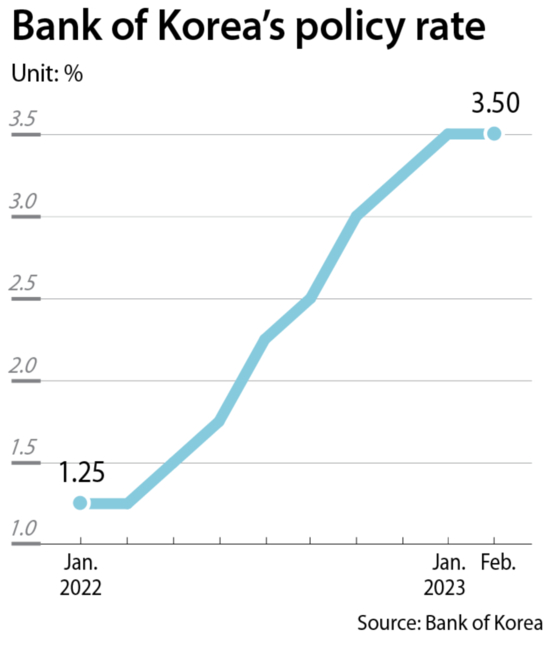Korea takes a breather on rates and holds them steady
![Bank of Korea Gov. Rhee Chang-yong speaks at a press conference held in central Seoul on Thursday following the Monetary Policy Board meeting held earlier in the same day. [BANK OF KOREA]](https://koreajoongangdaily.joins.com/data/photo/2023/02/23/864d0205-aa58-49af-8aee-364b971d3658.jpg)
Bank of Korea Gov. Rhee Chang-yong speaks at a press conference held in central Seoul on Thursday following the Monetary Policy Board meeting held earlier in the same day. [BANK OF KOREA]
The Bank of Korea kept its policy rate unchanged at 3.50 percent on Thursday in a widely expected move that came as inflation remains stubbornly high and as economic uncertainties linger.
With the central bank caught on a knife's edge between too much and not enough, it chose to take a breather.
One of the seven Monetary Policy Board members – Cho Yoon-Je – voted to raise the rate by a quarter percentage point.
It was the first time the board maintained the rate steady at a meeting since February 2022. The board rapidly upped the rate by a total of 300 basis points since it started tightening in August 2021.
“Inflation is projected to fall, but inflation above the target rate is expected to remain this year,” said Bank of Korea Gov. Rhee Chang-yong during a press event following the rate-setting meeting held in central Seoul on Thursday. “We decided to maintain the current rate as uncertainties in the policy conditions are high.”
Rhee stressed the Thursday decision shouldn’t be regarded as a halt of the monetary tightening.
“Before last year, it was common to take some time and review before deciding to raise the rate again.” Rhee added, “Today’s decision is returning back to the past method” of rate decision process.
The move was widely expected, according to a survey conducted by the Korea Financial Investment Association.
Sixty-six percent of respondents to the survey projected the central bank to keep the rate unchanged, citing concerns about Korea’s household debt and the possibility of a recession. Of those projecting a rate increase, 97 percent expected a quarter percentage point rise.
The survey was conducted Feb. 10 through 15 and involved 100 people covering bonds, including analysts and brokers.
Korea’s outstanding household loans reached 1,876.0 trillion won ($1.44 trillion) at the end of December, according to the preliminary data from the Bank of Korea Tuesday.

gra
“Monetary policy needs to focus on stabilizing inflation this year, while policy needs to be introduced designed to respond to economic uncertainties," according to the central banker on Tuesday.
“The central bank recently focused on financial stability and the economy rather than growth, which means the rate increase has ended,” said Yun Won-tae, an analyst at SK Securities. “But the Tuesday comment is a sign telling people not to feel too relieved even if the rate is unchanged as there is a possibility that the rate may rise again.”
The biggest concern for the Bank of Korea will be the policy rate difference with the Fed, Yun added.
The federal funds rate is currently 4.50 percent to 4.75 percent. The next two-day Federal Open Market Committee meeting starts on March 21.
“The majority of local brokers believe the rate increases ended following the Monetary Policy Board meeting in January,” Oh Chang-sup, an analyst at Hyundai Motor Securities, said. “That’s because an expression the board would continue the trend of rate increase wasn’t shown, and it mentioned the possibility of a minus economic growth.”
The Bank of Korea revised down this year’s growth forecast to 1.6 percent from the 1.7 percent projection made in November. It also lowered the inflation forecast for this year to 3.5 percent from the previous projection of 3.5 percent.
High oil prices, foreign exchange rates, the growth rate of public utility rates were noted as factors that may affect their inflation forecast.
The won returned to the 1,300-to-the-dollar range on Wednesday after hitting 1,216.4 in December. It traded at 1,297.10 when the market closed on Thursday.
Inflation returned to 5.2 percent in January from 5.0 percent a month earlier. The producer price index rose 5.1 percent on year in the same month from 5.8 percent a month earlier.
It would be too early to cut the policy rate until data shows inflation is clearly headed to the 2 percent target, according to Rhee.
The board expects consumer prices will fall to the 4 percent range in March and to the low 3 percent range by the year end. If the inflation follows the path, there would not be a need for the bank to make additional increases, Rhee added.
The Fed minutes for the January meeting showed on Wednesday that “members anticipated that ongoing increases in the target range would be appropriate in order to attain a stance of monetary policy that is sufficiently restrictive to return inflation to 2 percent over time.”
BY JIN MIN-JI [jin.minji@joongang.co.kr]










with the Korea JoongAng Daily
To write comments, please log in to one of the accounts.
Standards Board Policy (0/250자)